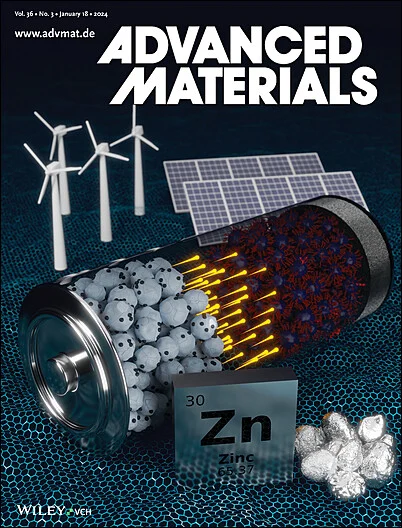通过定向氧化锌(002)刻面实现高度可逆的锌阳极设计
IF 27.4
1区 材料科学
Q1 CHEMISTRY, MULTIDISCIPLINARY
引用次数: 0
摘要
水性锌离子电池的实际应用面临着巨大的障碍,包括不受控制的枝晶生长、水引发的副反应、锌金属利用率不理想以及复杂的锌阳极制造。为了解决这些问题,我们设计了在锌阳极上大规模构建具有热力学惯性和亲锌动力学特性的高取向 ZnO(002) 晶格平面(ZnO(002)@Zn)。理论计算和实验结果都表明,ZnO(002)@Zn 具有较高的锌化学亲和性、氢演化反应抑制性和无枝晶沉积能力,这是由于 ZnO(002) 中含有丰富的晶格氧物种,且其与 Zn(002) 的晶格错配度较低。这些特点协同促进了离子传输,实现了均匀的锌沉积。因此,即使在较大的放电深度(85.6%)下,ZnO(002)@Zn 阳极也能显示出超过 500 小时的稳定而持久的循环寿命,并实现了令人印象深刻的 99.7% 的平均库仑效率。此外,其功效在 V2O5 阴极纽扣电池和袋式电池中也很明显,不仅放电容量高,而且循环稳定性极佳。这种集成方法为解决与锌金属阳极相关的挑战提供了一条大有可为的途径,从而推动了水性锌离子电池技术的发展前景。本文章由计算机程序翻译,如有差异,请以英文原文为准。

Highly Reversible Zn Anode Design Through Oriented ZnO(002) Facets
The practical implementation of aqueous Zn-ion batteries presents formidable hurdles, including uncontrolled dendrite growth, water-induced side reactions, suboptimal Zn metal utilization, and intricate Zn anode manufacturing. Here, large-scale construction of a highly oriented ZnO(002) lattice plane on Zn anode (ZnO(002)@Zn) with thermodynamic inertia and kinetic zincophilicity is designed to address such problems. Both theoretical calculations and experiment results elucidate that the ZnO(002)@Zn possesses high Zn chemical affinity, hydrogen evolution reaction suppression, and dendrite-free deposition ability due to the abundant lattice oxygen species in ZnO(002) and its low lattice mismatch with Zn(002). These features synergistically promote ion transport and enable homogeneous Zn deposition. Consequently, the ZnO(002)@Zn anode displays a stable and prolonged cycling lifespan exceeding 500 h even under a larger depth of discharge (85.6%) and realizes an impressive average Coulombic efficiency of 99.7%. Moreover, its efficacy is also evident in V2O5-cathode coin cells and pouch cells with not only high discharge capacity but also exceptional cycling stability. This integrated approach presents a promising avenue for addressing the challenges associated with Zn metal anodes, thereby advancing the prospects of aqueous Zn-ion battery technologies.
求助全文
通过发布文献求助,成功后即可免费获取论文全文。
去求助
来源期刊

Advanced Materials
工程技术-材料科学:综合
CiteScore
43.00
自引率
4.10%
发文量
2182
审稿时长
2 months
期刊介绍:
Advanced Materials, one of the world's most prestigious journals and the foundation of the Advanced portfolio, is the home of choice for best-in-class materials science for more than 30 years. Following this fast-growing and interdisciplinary field, we are considering and publishing the most important discoveries on any and all materials from materials scientists, chemists, physicists, engineers as well as health and life scientists and bringing you the latest results and trends in modern materials-related research every week.
 求助内容:
求助内容: 应助结果提醒方式:
应助结果提醒方式:


